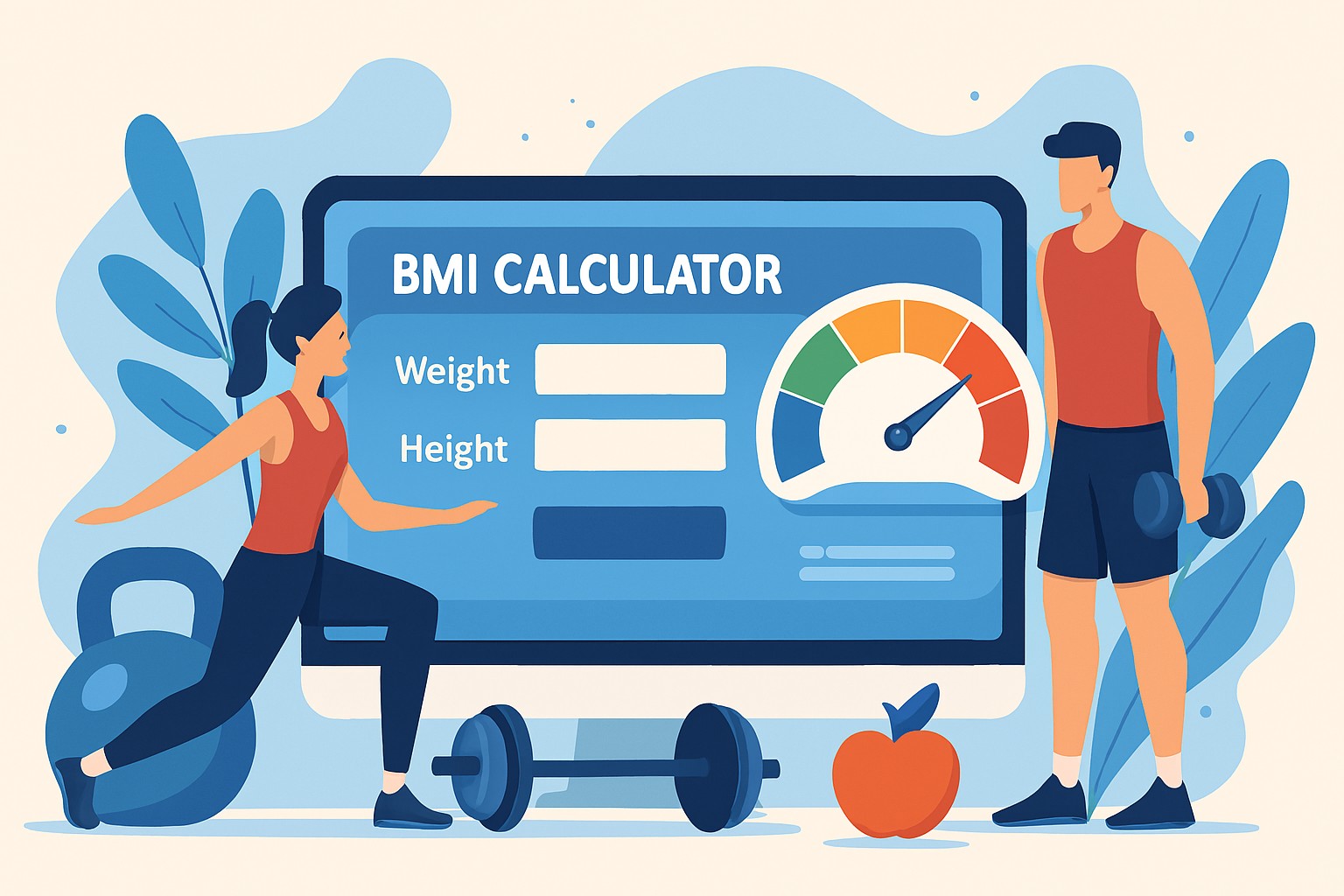BMI Calculator: The Tiny Tool That Can Transform Your Health
In the pursuit of fitness and wellness, people often turn to intense workouts, exotic superfoods, expensive trackers, and complicated diet plans. But one of the most powerful tools in health and fitness doesn’t come wrapped in complexity—it comes as a simple calculation. It’s called the BMI Calculator, and it has quietly helped millions of people around the world understand their health status in just a few keystrokes.
BMI, or Body Mass Index, is more than just a number. It’s a tool of awareness, a spark for motivation, and a universal checkpoint used by health professionals, athletes, and everyday individuals alike. It doesn’t require an app subscription or a gym membership. All it asks for is your height, your weight, and a moment of your time. But what it can give you in return is priceless: insight into your well-being, clarity about your current state, and a baseline from which to grow stronger.
BMI Calculator
What is a BMI Calculator, Really?
The BMI Calculator is a simple tool designed to determine your Body Mass Index, which is a number derived from your height and weight. It’s used as a general measure to indicate whether an individual has a healthy body weight for their height. The idea behind it is beautifully straightforward—if your weight is proportionate to your height, your body is likely in balance. If your weight is too high or too low for your height, it may suggest a potential health risk.
But make no mistake—this is not just some digital novelty. The BMI Calculator is backed by decades of research and endorsed by organizations like the World Health Organization and the Centers for Disease Control and Prevention. It’s used in medical clinics, in fitness programs, and in national health statistics. Why? Because it gives a quick, general assessment of body composition that can guide meaningful decisions.
And while it doesn’t tell the whole story—no single metric ever does—it’s an incredibly powerful first step.
Understanding the Math Behind the Metric
Many people use BMI without knowing how it’s calculated. But once you understand the formula, you gain a deeper appreciation for its simplicity and purpose.
In the metric system, the formula is: BMI = weight (kg) / height (m²)
So, if someone weighs 70 kilograms and is 1.75 meters tall, the calculation would look like this: BMI = 70 / (1.75 × 1.75) = 22.86
In the imperial system, the formula is a bit different: BMI = (weight in pounds / height in inches²) × 703
So, a person weighing 154 pounds and standing 68 inches tall would calculate: BMI = (154 / (68 × 68)) × 703 = 23.4
In both cases, the result is a number typically ranging between 15 and 40, and that number fits into categories defined by health organizations. Generally speaking, a BMI under 18.5 is considered underweight, 18.5 to 24.9 is normal, 25 to 29.9 is overweight, and 30 or above is categorized as obese.
The beauty of this system lies in its accessibility. You don’t need a lab or a personal trainer to understand it. You can calculate it yourself, or use any number of online BMI calculators to do it for you instantly.
What That Number Really Means
Getting your BMI number is easy. Understanding what it means is the part that can truly change your life.
The BMI number is essentially a reflection of how your weight compares to your height. If your BMI falls within the “normal” range, that typically means your weight is well balanced with your height and that you may be at lower risk for health problems like diabetes, heart disease, or high blood pressure.
If your BMI is higher than the normal range, it might suggest you’re carrying extra body fat, which can increase those same health risks. And if it’s lower than normal, it could mean you’re not getting enough nutrition or that your body is under strain from being underweight.
But here’s the important part: your BMI is a guidepost, not a verdict. It’s a flashing light that says, “Check in with your body.” It’s a number that opens the door for reflection, not a hammer of judgment.
BMI Is Your First Checkpoint, Not Your Final Destination
So many people get discouraged when they see their BMI is higher or lower than expected. But the truth is, that number should be a motivator—not a roadblock. When you know where you stand, you can create a path forward. You can set goals that are rooted in reality. You can take control instead of drifting.
Think of BMI as your starting line. You’re not racing anyone but yourself. And every step you take after calculating your BMI can be measured, tracked, and celebrated. Maybe you’ll adjust your eating habits. Maybe you’ll move more throughout the day. Maybe you’ll start strength training or walk your dog twice instead of once. All of those decisions can move the needle.
The BMI Calculator gives you something powerful: it gives you direction.
A Universal Tool That Belongs to Everyone
What’s truly inspiring about the BMI Calculator is that it belongs to everyone. It doesn’t care how much money you make, how old you are, or whether you’ve ever stepped foot in a gym. It doesn’t require apps, devices, or subscriptions. It simply reflects your data.
And while no tool is perfect—BMI doesn’t distinguish between fat and muscle, for example—it works beautifully as a first layer of health insight. Athletes with high muscle mass might score a higher BMI even though they are incredibly healthy. Conversely, someone who appears lean might have a normal BMI but still face hidden health risks like visceral fat or metabolic disorders.
That’s why BMI isn’t meant to replace full-body health assessments. It’s meant to start the conversation. It’s a number that says, “Here’s what I see—what will you do with this?”
Using BMI as a Motivation Multiplier
One of the most exciting things about the BMI Calculator is how it can supercharge your motivation. It’s tangible. It’s trackable. It gives you a baseline—and as humans, we thrive on measuring progress. Whether you want to maintain your weight, shed a few pounds, or gain strength, BMI lets you see the trend.
Imagine checking your BMI today and setting a goal to reduce it by one point in three months. That’s achievable. That’s specific. That’s motivational. And when you hit that goal, you’ll feel a rush of pride, knowing you moved the needle by making consistent choices day after day. BMI is not about perfection. It’s about direction. It’s a north star you can check as often as you like, knowing each visit brings you closer to your healthiest self.
The Emotional Side of BMI—Facing It With Courage
Let’s not pretend that calculating your BMI is always a joyous occasion. For many people, it’s a moment filled with anxiety, shame, or even regret. But it can also be one of the most courageous things you ever do. Looking at the number, especially when it’s not what you hoped, is a radical act of self-awareness.
It takes bravery to say, “I see the number. I don’t love it. But I’m going to change it.” That’s not weakness. That’s strength. That’s growth. That’s ownership. Remember, the BMI Calculator isn’t judging you. It doesn’t know your history, your genetics, your struggles, or your journey. I t simply gives you a number—and then invites you to take action based on your goals, your values, and your truth.
BMI and the Bigger Picture of Wellness
It’s crucial to keep in mind that BMI is only one piece of the puzzle. True wellness is a mosaic made of many pieces: mental health, emotional balance, sleep quality, hydration, strength, energy levels, and joy. You could have a perfect BMI and still feel sluggish or disconnected. You could have a high BMI and still be strong, happy, and making great strides in your fitness.
Use BMI as a helpful check-in, not as your sole measurement of success. Pair it with other tools, like waist-to-hip ratios, body fat percentage, energy tracking, and emotional well-being assessments. When you view your body holistically, you’re more likely to take compassionate action—and less likely to burn out from comparison or shame.
A Tool to Inspire Generations
Perhaps one of the most beautiful things about BMI is how it can be used across generations. Parents can teach their teens about BMI as a gateway to body awareness—not body obsession. Adults can use it to reverse unhealthy trends before they become serious. Seniors can use it to monitor how their body changes with age and ensure they maintain healthy weight for mobility and energy.
Because BMI is so simple, it creates a common language between generations. It invites people to talk openly about health, to support one another, and to rally around shared goals. It’s not just a solo tool. It can be part of a community of wellness.
BMI Isn’t Your Identity—It’s a Launchpad
Here’s the most important takeaway of all: your BMI is not who you are. It’s a single data point. It doesn’t measure your kindness, your talents, your ambition, or your resilience. It doesn’t know your heart. But it does offer something powerful—a launchpad. A place to leap from. A place to set goals from. A mirror that reflects your current moment, not your final chapter.
And if you use it wisely—if you meet it with curiosity and courage—it can be one of the most empowering tools you ever use.
Final Thoughts: A Simple Number That Can Set You Free
In a world full of trends and complexity, the BMI Calculator stands out for its simplicity. It’s easy to use, easy to understand, and easy to act on. But its simplicity doesn’t mean it’s small. It can lead to big decisions, big improvements, and big wins. The kind that come not from dramatic overhauls but from thoughtful, consistent steps in the right direction.
So whether you’re looking to get healthier, stay on track, or simply understand your body a little better, start with your BMI. Calculate it. Reflect on it. Use it as a catalyst. Because the most powerful changes in life often begin with the smallest, smartest steps—and this might be yours. Let the BMI Calculator be your guide, your mirror, and your launchpad into the healthiest, happiest version of yourself.



